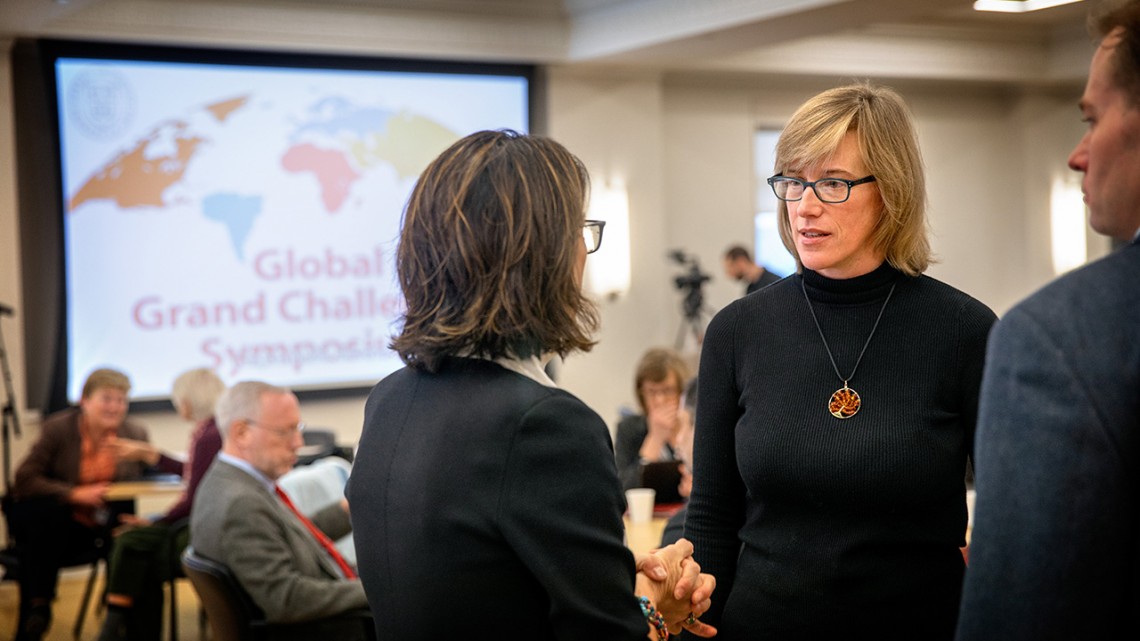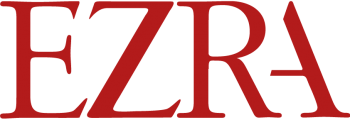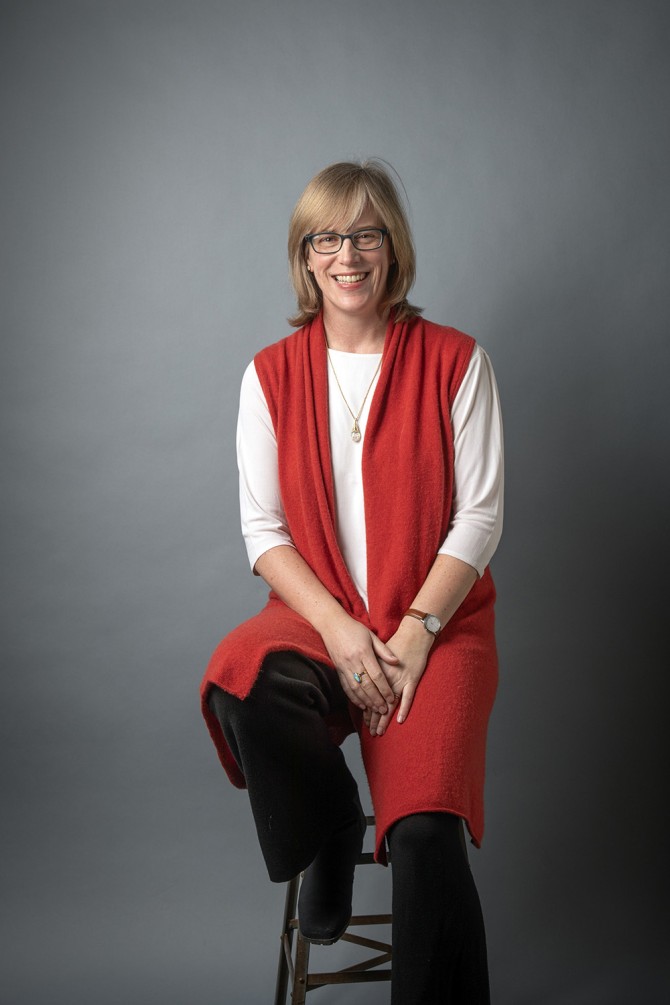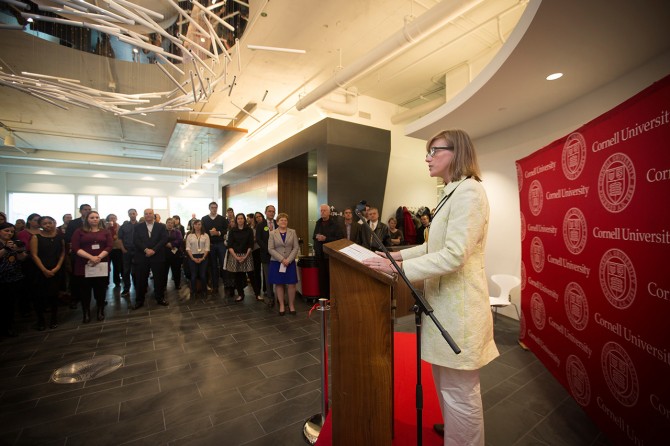
Katherine McComas, vice provost for engagement and land-grant affairs, chats with attendees at the Global Grand Challenges Symposium held in November 2018 in Warren Hall.
Vice provost keeps Cornell’s engagement mission vibrant and relevant
By Joe Wilensky
Katherine McComas, Ph.D. ’00, professor of communication in the College of Agriculture and Life Sciences, is Cornell’s vice provost for engagement and land-grant affairs.
As vice provost, she serves as the academic lead for the universitywide Engaged Cornell initiative; advocates for Cornell’s role as New York’s land-grant university; represents Cornell’s four contract colleges in dealings with the State University of New York; and oversees Cornell’s ROTC program, the Cornell Prison Education Program and the university’s Office of Engagement Initiatives.
How have you experienced and embraced Cornell’s land-grant mission and “knowledge with a public purpose” philosophy?
It’s something that has always figured prominently in my career and also in my interests. I started out being particularly interested in journalism around issues related to science and the environment. When I came to Cornell in 1994 as a doctoral student, my interests were in communicating about health and environmental risk. I quickly became involved with Cornell Cooperative Extension, working with different extension associates around issues related to waste management, for example, or communicating to farmers about tractor safety.
At Cornell, the public engagement mission, the knowledge with a public purpose, and wanting to engage with communities – it’s a core mission. It doesn’t just reside in our four contract colleges, although they do have that special responsibility in terms of our relationship with New York state.
When I came back to Cornell as a faculty member in 2003, it was sort of like coming home. I was happy to be able, once again, to participate in communication that has basic scientific elements and also the practical implications of working with communities around issues of health and environmental and scientific risks. And that’s been my research program, basically, for my career: looking at community engagement, at decision making, typically in the context of health and environmental risks.
So when the opportunity arose almost a year ago for me to advance into this vice provost position, to help steward and build on that public engagement mission, it was very exciting.
What are some of the things that are new with your vice provost role as it has developed with this particular provost and president?
Provost Mike Kotlikoff has established a public engagement council of senior staff and faculty across the university. I work with this group to articulate a contemporary vision for public engagement that builds on Cornell’s strengths and research in many different domains. Also, I work closely with the provost's fellow for public engagement, Gerard Aching, professor of Africana and Romance studies, on advancing all forms of engagement – such as the Rural Humanities initiative, which, under the aegis of the Society for the Humanities, connects scholars and students in humanities with community partners in upstate New York.
Another priority of the provost and President Martha E. Pollack is our New York City visioning efforts, which are part of the larger “One Cornell” ethos of bringing all our campuses closer together so we can realize the synergies.
We are viewing these synergies through the broader scope of public engagement. When I think about New York City and all the public engagement activities that are happening there – through Cornell University Cooperative Extension-NYC, different K-12 programs and many other types of impact programs – they all fit within this New York City engagement vision and presence.
And now, with the new ILR School hub at 570 Lexington Ave. and others co-locating there, including Engaged Cornell, we will be able to help forge those community partnerships and provide more opportunities for our students to have engaged learning opportunities in the city. It’s a more direct presence we haven’t had before, working in partnership with our Cornell Cooperative Extension collaborators and other neighbors.
How do you see public engagement and Engaged Cornell as they fit into the president’s priorities for the university?
In particular, I see them as fully aligned with her priorities of academic distinction, educational verve and civic responsibility.
We want to attract the best faculty to maintain our academic distinction, and some of those best faculty are interested in the latest and the most up-to-date pedagogies, which include experiential learning. That ties into educational verve: having these opportunities not only for active learning inside the classroom, but active learning outside the classroom through community-engaged learning with partners.
Our role within civic responsibility is around diversity and inclusion; one of the many reasons that inclusivity is a priority is the need to be able to talk to people across differences. That’s something we do through public engagement, especially Engaged Cornell, exposing our students to going outside of the classroom, outside of the walls of Cornell, out into communities, whether that’s in Tompkins County or Thailand.
Learning to interact with people, learning to develop empathy for people who may be coming from a very different environment than they’ve been used to, is tied to achieving a high level of civic competence. And that is something we want to see in the students we graduate from an Ivy League university with a land-grant mission.
What is one individual example of the transformative impact of Cornell’s engaged learning that has stayed with you?
The Cornell Prison Education Program. As its executive director Rob Scott describes, CPEP has a dual transformational impact: It not only works to help to transform the lives of the inmates by giving them access to college credits and college-level courses, but it also transforms the faculty and the staff and the students, graduate and undergraduate, who go and teach these courses. They engage with this population, which helps develop their own thinking about mass incarceration and also can develop their greater empathy for others.
It hits the mark for community-engaged learning and transformative impact, and it also serves as an example for prison education across the country. I’m looking forward to going to my first CPEP graduation in June.
Do people in general have an accurate picture of Cornell’s engagement efforts and land-grant mission?
I think there is more work to be done to communicate what this means in a way that really captures people’s awareness and their excitement about what we’re doing. It can look different across the university, and I think we need to do a better job of packaging that.
Philosophy professor Kate Manne is a prolific scholar who also publishes essays in leading media outlets. She is an example of a faculty member deeply and consistently engaging in our land-grant mission of outreach and knowledge. There are many examples across the university of people where you’d say, “Well, that’s in a field that traditionally wouldn’t really be public engagement” – but that’s really not what I see at Cornell. There are more people than you realize doing public engagement in their own way, form and fashion.
It’s different, depending upon where you’re sitting: what discipline, what field, what college or school. But it is something that’s valued. It is part and parcel of how we understand our university, and how we attract students, staff and faculty.
Much like Ezra Cornell’s founding declaration of “any person … any study” captured the essence of part of our vision, the land-grant mission is also part of the essence of our founding. It should be inextricably entwined with how we talk about Cornell.
What has your work been like with policymakers and others in Albany and the State University of New York?
I’ve mostly interacted with SUNY central – the chancellor’s office, the provost and the folks that run the State University Construction Fund, because I work with facilities around how the funds come to Cornell that then are allocated toward capital and building projects in the contract colleges. On the academic side, a lot of these conversations are around reviews for our new programs, course syllabi and degree requirements, as well as working to best use the funds that are allocated to us from the state for our contract colleges.
I’ve had a few opportunities to meet with non-SUNY folks, including state legislators and recently the governor. And I had a great trip to the Great New York State Fair, organized by CALS. So that’s still definitely a learning curve, and I know that more time on the job will afford those opportunities.
What are ways you would like to continue to make Cornell’s engagement work accessible and relatable to alumni?
We’ve been thinking a lot about alumni engagement along with our focus on public engagement. We know that there are many alumni – through their careers, through their volunteer work, through public service – who are role models for public engagement. Some of them, for example, have been winners of the Cornell New York State Hometown Alumni Award. So we’re interested in understanding, how can we better support alumni in their lifelong commitment to public engagement and, to the extent that that comes back to connect with the university, what opportunities are there to work with us?
Certainly, it’s through alumni and their generosity that we’ve been able to undertake so much of what we’ve done around Engaged Cornell, due to the wonderful support from the Einhorn Family Charitable Trust and many others.
I’d love to raise the visibility in terms of alumni working with us as community partners for engaged learning or engaged research opportunities; I’d love to enlist even more alumni as emissaries for communicating about the public engagement distinction of Cornell – for them to share their stories, and their willingness to connect, with students and the university.
Media Contact
Get Cornell news delivered right to your inbox.
Subscribe




